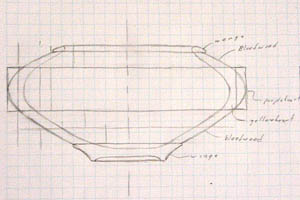 |
Design Here is the plan.
Hopefully, it'll turn out pretty close.
|
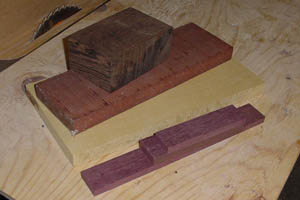 |
Materials Luckily, I was
able to find enough of all the woods I wanted to use.
Some of it was leftovers from other projects, but this'll
put them to good use. Here is some wenge, bloodwood,
yellowheart, and purpleheart.
|
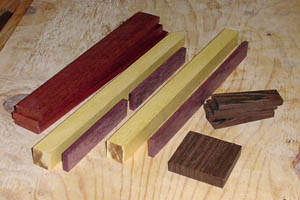 |
Preparing the Stock I
ripped the stock to all the thicknesses that I'll need.
|
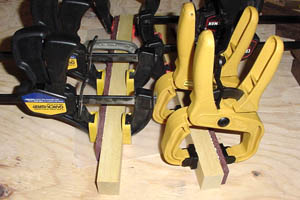 |
Laminating the pieces for the ring with
the ovals The thinner purpleheart layer
will form the ovals and the thick yellowheart will be the
background.
|
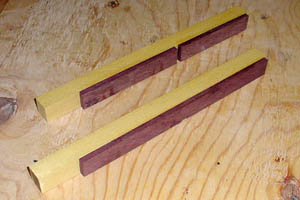 |
Ready for cutting The
laminating is complete. A little planning allowed me to
use the scrap purpleheart strips. I'll have just enough
to get the number of segments needed. (3 out of the top
one and 4 out of the bottom.)
|
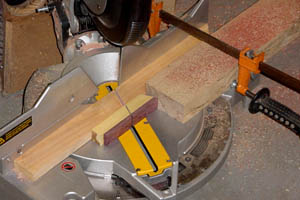 |
Cutting I almost forgot to
take a picture. This is the last piece of the oval
section just after being cut. The picture shows my setup.
Not pretty, but it works. I make test cuts on some scrap
pine to get the saw adjusted precisely before I started
cutting on the real thing. The cuts have to be perfect
for the ovals to come out right.
|
 |
All pieces cut This shows
all of the pieces cut and laid out nicely for the
picture. I usually start gluing before I get all the
pieces cut, but it's easier to show this way.
|
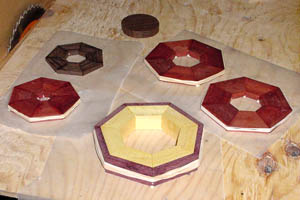 |
Gluing the rings Here all
the rings are glued and clamped with rubber bands.
|
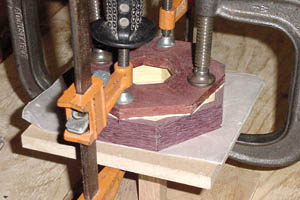 |
Stacking the rings The
rings are centered and glued together to form the blank
|
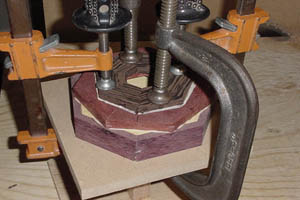 |
More stacking Normally, on
most open bowls this process would continue until all of
the rings are stacked. Since the centering must be
perfect on the layer with the ovals I'll turn this bowl
in two sections leaving the critical "oval"
layer on the outside of one section. This will allow for
perfect centering and help in the hollowing process.
|
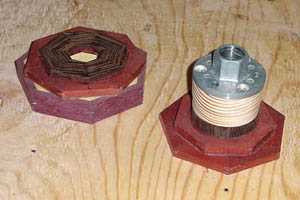 |
The blanks Here are the two
sections completely glued. The bottom layer (on the
right) has a scrap block glued to the bottom and a
faceplate attached, but I'll start turning the top
section first (the one on the left).
|
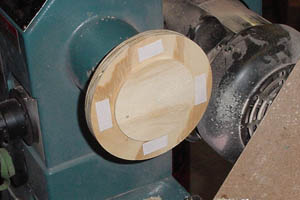 |
Making an auxilliary faceplate A
scrap piece of plywood is mounted to the faceplate. I
turned a short spiggot on the plywood just large enough
for the "oval" ring to fit over with a snug
fit. This is not to hold the blank, but it will insure
that the ring will be perfectly centered and won't slip
out of place. I put pieces of double stick tape on the
faceplate to actually hold the blank.
|
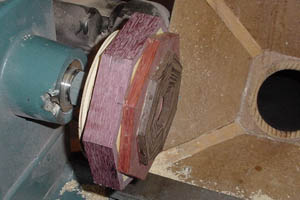 |
Mounting the first section This
shows the top section mounted and ready to turn.
|
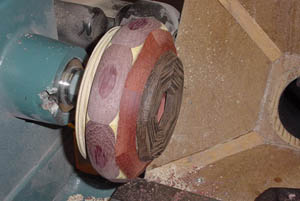 |
Turning While the blank is
being roughed out the ovals begin to form.
|
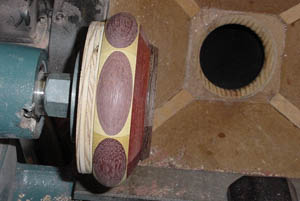 |
Getting the ovals right I
go ahead and shape the bowl using the ovals as a guide
when to stop. I hold off on shaping the rim at this
point, because I'll need that area for holding the piece
when I turn it around to do the inside. I did go ahead
and round out the center of the rim and true up the face
for the next step.
|
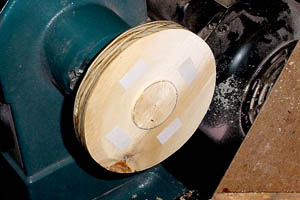 |
Another auxilliary faceplate This
could have been the first auxilliary faceplate with the
spiggot turned smaller to fit the hole in the rim just
turned. This one was just made from another piece of
scrap. More pieces of tape will hold the blank.
|
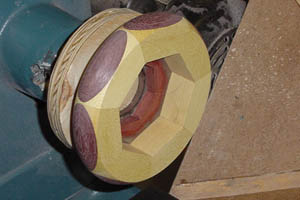 |
Reversing the Blank The
blank is removed from the other aux. faceplate and
remounted in reverse to this one so that the inside can
be turned.
|
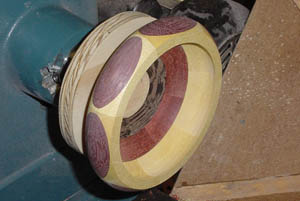 |
Turning the inside The
inside is turned to final thickness with a tad extra left
on where the two sections will be glued together. This
will finish up the hollowing for this section except for
the joint where the sections are glued together. I went
ahead and sanded the inside at this time.
|
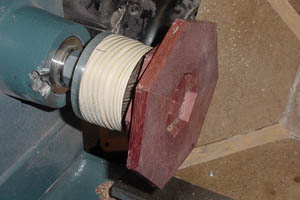 |
Mounting the bottom section The
other section doesn't have to be centered as precisely as
the section with the "oval" layer, so I can
start turning it as I have it mounted already.
|
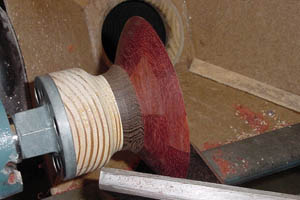 |
Turning the outside I
shaped the outside to near final dimensions except for
the base, which I wanted to have wider for more support
during the turning process. I did go ahead and get the
top close to the final diameter. I stopped the lathe
frequently and matched the top section to the bottom so
that I could get the diameter and curvature just right.
|
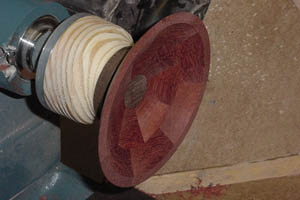 |
Turning the inside I turned
the inside to match the outside.
|
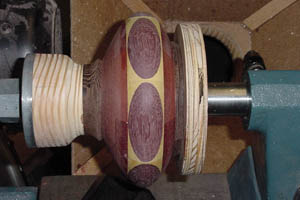 |
Putting the two sections together Leaving
the bottom section on the lathe and with the top section
still attached to the aux. faceplate I glued the two
sections together being careful to line the joints up to
match the alternate layer on the opposite section. The
tailstock provides a nice clamp for the two sections, I
just have to make sure that the two sections remain on
center until the glue sets.
|
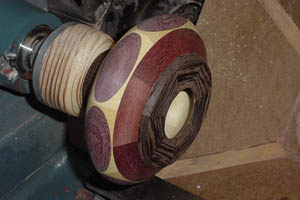 |
Clean up the glue joint I
removed the aux. faceplate from the rim and cleaned up
the transition between the two sections, so that the
curve flowed smoothly and there is no distinction between
the two sections.
|
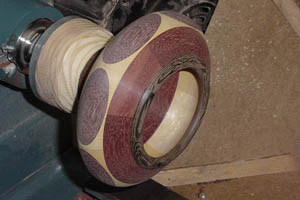 |
Turning the rim Here the
rim is turned to the final shape, and the joint between
the two glued sections is cleaned up on the inside.
|
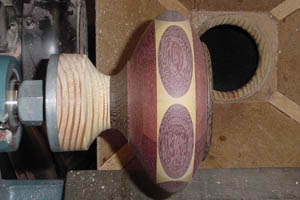 |
Turning the base Well, I
can't really get to the base very well, but this shows
where I shaped it to very near the final shape. Sanding
is completed at this point on all parts except for the
base.
|
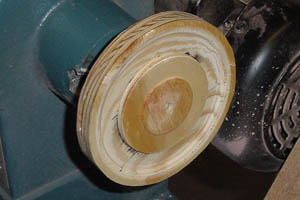 |
Getting ready to finish the bottom Now
that I have put all this effort into this project and it
has turned out so well to this point I surely don't want
to have the bowl fly off the lathe and bounce across the
shop floor. So, I'll put a little extra effort into
holding the bowl, since I'm doing this without the use of
a chuck. I make a sort of jam chuck by turning a shallow
spiggot on the scrap wood to press fit inside the rim,
and I drill a hole for a bolt to go through the center.
|
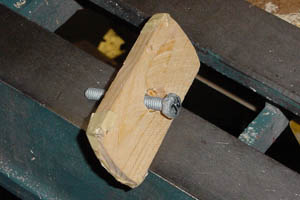 |
Making the cleat Actually,
I had this one already made. I have used it once or twice
before, so I didn't want to make another one. It's just a
piece of scrap wood rounded and sanded with some tape on
it to cushion the area that will be against the bowl. A
hole is drilled in the center and countersunk to hold a
long bolt.
|
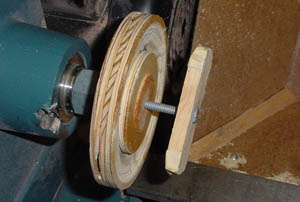 |
Attaching the cleat I did
this with the faceplate off the lathe. The picture just
shows how the cleat will be oriented once it's inside the
bowl. The bowl is slipped over the cleat and a nut is
tightened onto the bolt that protrudes through the
backside of the faceplate.
|
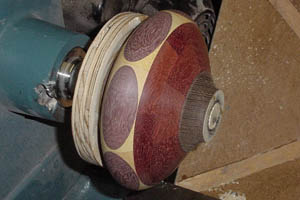 |
Mounting the bowl Here is
the bowl mounted on the reinforced jam chuck, or whatever
you want to call it. It is actually sturdy enough for
some fairly heavy turning, but there's none of that left
to do.
|
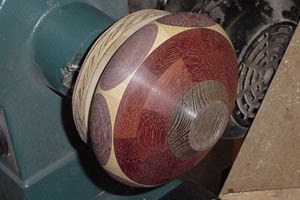 |
Turning the bottom Now the
bottom can be turned to the final shape and sanded. This
completes the bowl except for the finish.
|
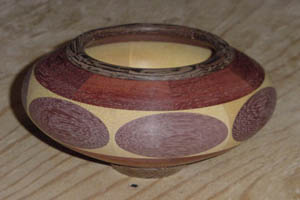 |
Turning completed Here's a
view of the freshly turned bowl. All that's left is a few
coats of wipe on poly.
|